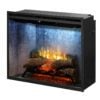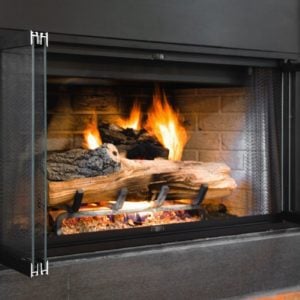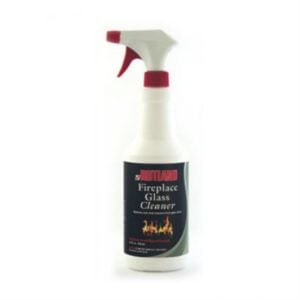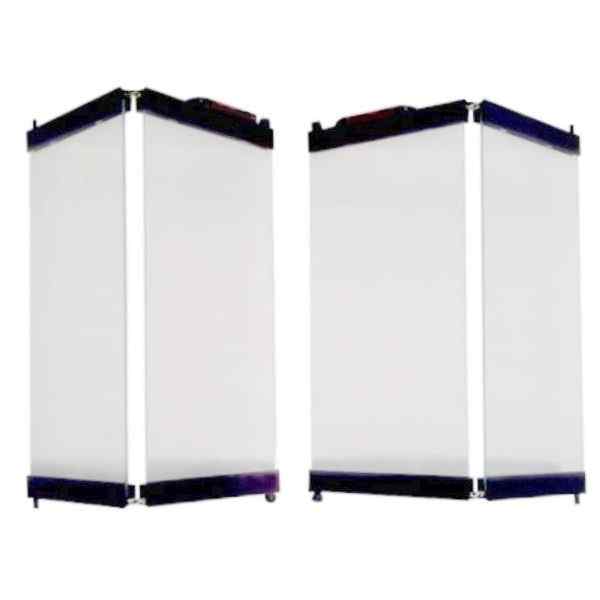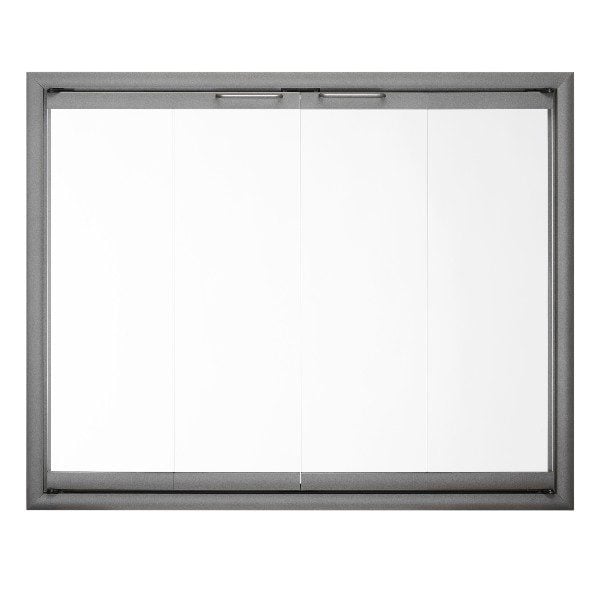Cleaning methods:
Now that you are prepped, it’s time to choose the best glass door cleaning method for you.
Fireplace door glass cleaner
Most of the time, you’ll just want to use a good glass cleaner and cloth, especially when the dirt hasn’t built up too much. You don’t want to go for the cheapest or most widely available option, so we recommend the Rutland Fireplace Glass Cleaner.
This innovative solution comes in an easy-to-use spray bottle, which means no heavy lifting and no mixing of your own ingredients. The magical formula has been designed to remove creosote, soot, and grime, on any glass fireplace door as effectively as possible. The best part? It’s non-acidic and completely safe to use.
The best way to use this product is to wait for your fireplace doors to cool down and wear some form of gloves to protect your hands in case of sharp edges or soot. Only use this product on its own, as if you mix it with other commercial cleaning products, it may end up damaging your glass door rather than cleaning it.
Spray some of the formula on the dirty area and use a clean rag to wipe it in a circular motion without leaving any streaks or marks. The formula will not scratch the glass; instead, you’ll be looking at a fireplace door that is as good as the day you bought it.
Make the most of old newspaper
If you’re one of those people who has a stack of old newspapers sitting in a cupboard somewhere and doesn’t know what to do with them, then we have some good news for you. If you mix it with a little bit of ash from your fireplace, you can use the two to keep your glass doors clean all year round.
You only need three things to use this cleaning method: newspaper, ash from your fireplace, and some water. It may seem weird to use ash to clean up soot, but believe it or not, it’s a great substance to clean most surfaces. If you try this method and see how well it works on the fireplace glass doors, you can also use it on other furniture surfaces.
The process is also extremely simple. You will need to wet a piece of old newspaper and then dab it in a bit of the ash that is sitting in your fireplace. From there, find the section of the glass doors you wish to clean and wipe the newspaper in a circular motion. It may take a few scrubs, but you should eventually see a sparkling difference.
Magic sponges do the trick
Have you ever heard of magic sponges and what they do? The name really says it all because they work like magic. It looks like a simple block of white foam, but it can remove some of the toughest stains off any surface, including dark soot off the glass doors of a fireplace. It’s a great solution to introduce into the routine cleaning of any area.
These items are extremely cost-effective and can be used several times. They are especially great if you have a stubborn glass door that won’t come off its hinges, as they can easily reach difficult places. The only other items you need to use a magic sponge is a little bit of water to soak into it and a cloth to dry off the glass once you’re done.
Using the magic sponge is easy. Pour some water on it, and start scrubbing the area that you would like to clean. For regular cleaning, you can just go over the entire area of the glass door. It’s a highly durable product and can remove some of the toughest soot stains. You don’t typically have to use gloves, but it is recommended whenever you clean your fireplace. Once you’ve scrubbed with the magic sponge, finish by drying off with a cloth.
Vinegar is a secret ingredient
Vinegar is an ingredient of many uses. Not only is it used in various types of cooking, but it’s an acidic ingredient that works exceptionally well in cleaning stubborn stains on various surfaces. When you mix it with a little bit of water, it becomes diluted and one of the best household items you can keep in your home.
It is cost-effective and easy to find in any store when you are struggling to get your hands on a good glass cleaner. It’s up to you if you want to use it on its own or mixed with a little bit of water, and it will all depend on the amount of soot you are trying to remove. The perfect combination is one cup of vinegar, three cups of water, and a little bit of ammonia shaken up in a spray bottle.
When you use the solution, you’ll want to spray it on any desired areas you wish to clean. Leave the mixture sitting there for at least 30 seconds, and then grab a cloth to start scrubbing the dirt off. Depending on how much dirt there is, it may take a few passes, but overall, you’ll leave with a gleaming surface to look at.
Scrape with a razor blade
Now, this one may seem a little strange, as surely a razor blade will do more harm than good? Well, it’s actually one of the top tools used by people who clean glass doors on fireplaces because it can help scrape off tough grime and soot.
When you notice there’s an extremely heavy layer of grime on your fireplace’s glass doors, you may not want to use one of your beloved rags, and even the toughest of solutions could take a while to get through it. That’s why you may want to grab a small razor blade and start cutting through the grime until there’s only a small layer left.
It’s best to use some safety gloves as razors are sharp, and you don’t want to cut yourself. Regular cleaning gloves may be too thin and better suited for using sprays and detergents. Then, you’ll want to place the blade at a 45-degree angle and start pushing the grime off the glass. Try to be gentle, so you don’t damage the glass. Once you’ve removed most of the soot and grime, you can start using one of the gentler cleaning methods to finish off.
Final thoughts
There are many fantastic ways to remove grime and soot from your glass fireplace doors, and the method you use will all boil down to your personal preferences and the type of fireplace you have. Make sure you remove the doors if you can, and you’ll notice that the job is much easier to do. From there, keep to a cleaning schedule, and you’ll never have to stare at black and dirty doors again.




